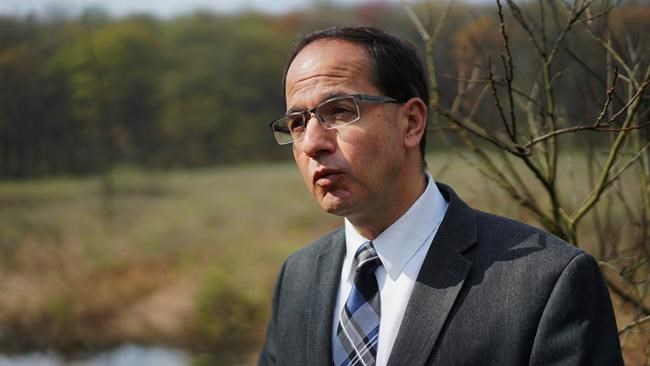
FILE - In this April 20, 2017 file photo, Green Mayor Gerard Neugebauer speaks in front of wetlands where a proposed pipeline would run through in Green, Ohio. Officials in Green in southern Summit County are waging a battle on different legal fronts against a partnership that has federal approval to begin construction on the $2 billion NEXUS pipeline. (AP Photo/Dake Kang)
Republished November 04, 2017 - 9:25 AM
Original Publication Date November 04, 2017 - 8:46 AM
CLEVELAND - As a partnership between companies based in Canada and Detroit begins the first steps in building a $2 billion natural gas pipeline, a northeast Ohio mayor is vowing to continue his city's fight to get the pipeline moved away from his community of 25,000 residents, "as long as there is hope."
"I'm not opposing oil and gas," Green Mayor Gerard Neugebauer told The Associated Press this week. "What I'm saying is that you should not go through populated areas when you put in a pipeline."
The partnership between Calgary-based Enbridge and Detroit's DTE Energy has received all the federal approvals it needs to build the 255-mile-long NEXUS pipeline, which will be capable of transporting 1.5 billion cubic feet of gas per day from the shale fields of Appalachia across northern Ohio and into Michigan and Canada. A little more than 200 miles (321.85 kilometres) of the pipeline will be in Ohio with nearly 8 miles (12.87 kilometres) in Green.
Neugebauer and his administration began attempts to move the pipeline's proposed route south to more rural areas after the project was announced more than two years ago. Green's alternate route proposed early on by city engineers was rejected by NEXUS as too costly. The Federal Energy Regulatory Commission, which voted in August to issue the project its key Certificate of Public Convenience and Necessity, clearing the way for construction, concluded the Green route provided no benefits over NEXUS' route.
The city's last-ditch efforts are now being waged in federal courts.
Attorneys for Green last month petitioned the 6th Circuit U.S. Court of Appeals, challenging the Clean Water Act permit the Ohio Environmental Protection Agency issued for the project. The petition argues the EPA didn't fully consider potential damage that construction could cause to wetlands and environmentally sensitive areas in the city. NEXUS joined the EPA in defending the agency's actions. A decision is pending.
The city has refused NEXUS' $146,000 offer for easements on city-owned parcels and roadways after being named as a defendant in a federal eminent domain lawsuit filed by NEXUS to obtain property it needs for construction and permanent access to the pipeline.
And NEXUS sued the city last week in U.S. District Court when Green issued an order stopping workers from using vacant property the partnership had leased for construction equipment and materials. Green argues the city's land use code doesn't allow for storage on vacant property. NEXUS said federal approvals trump city codes.
NEXUS spokesman Adam Parker said the partnership doesn't comment on pending litigation. Parker said NEXUS has acquired easements for 97 per cent of the property along the pipeline's route and that the project is on target to begin transporting gas next fall — a year later than originally planned.
History is on NEXUS' side. There are no known instances of a pipeline project being derailed after receiving FERC approvals have been issued.
Neugebauer insisted that the city's efforts shouldn't be seen as futile.
"It takes just one judge to say you can't build this here because this is wrong," Neugebauer said. "I hold out hope that this will come."
Green has much at stake, he said. The city commissioned a study by Cleveland State University that concluded Green could lose tens of millions of dollars in economic development opportunities because of the pipeline, which will be routed near the city's foreign trade zone outside Akron-Canton Airport.
Seventeen of the city's 26 athletic fields are within 1,500 feet of the pipeline's expected blast zone should a catastrophic failure occur, Neugebauer said, adding: "I hope I don't have to make decisions about whether to put people in harm's way."
News from © The Associated Press, 2017